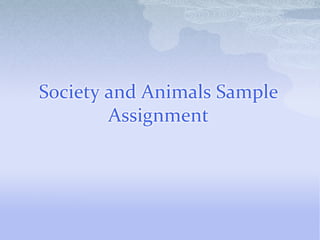
Society and animals sample assignment
- 1. Society and Animals Sample Assignment
- 2. Deconstructing the assignment Overview of texts Intent of assignment Sample student response
- 3. Synopsis of Assignment Each person will submit a PowerPoint presentation, or other electronic presentation, that features gathered social media (webpages, images, tweets, videos, etc) that extends the discussion of the social imaginary and animals and/or animals and the environment to a case of your choice. The presentation should include the following: I. A brief description of how the selected subject matter relates to one or more of Waldau’s Four questions; II. At least one reference to Herzog; III. At least one reference to Nibert and/or Mooallem; IV. A brief discussion of how understanding this topic contributes to a greater understanding of the broad field of Society and Animals. Each presentation should include a brief (2-3) page summary of the presentation and its findings.
- 4. Animal Studies: An Introduction Author: Paul Waldau Core: “Animal studies” is a growing, interdisciplinary field
- 5. Some We Love, Some We Hate, Some We Eat: Why It's So Hard to Think Straight About Animals Author: Hal Herzog Core: How we think about animals is rooted in human perceptions and Interactions, not in the “nature” of animals
- 6. Animal Oppression and Human Violence: Domesecration, Capitalism, and Global Conflict Author: David A. Nibert Core: Human history and societies cannot be adequately understood without understanding the roles played by “domescration”
- 7. Summary of Animal Rights/Human Rights Primary variables Factor One: Economic exploitation; Factor Two: Unequal power “largely vested in control of the state”; Factor Three: Ideological control
- 9. Wild Ones: A Sometimes Dismaying, Weirdly Reassuring Story About Looking at People Looking at Animals in America Author: Jon Mooallem Core: How do we come to identify with certain animals, many of which we have never met? New York Times 100 Notable books of 2013
- 10. Two cases: Polar bears and whooping cranes
- 11. International Union for Conservation of Nature and Natural Resources Red List of Endangered Species Taxonomy [top] Kingdom Phylum Class Order Family ANIMALIA ARTHROPODA ARACHNIDA ARANEAE LYCOSIDAE Scientific Name: Pardosa diuturna Species Authority: Fox, 1937 Common Name/s: English – Glacier Bay Wolf Spider Assessment Information [top] Red List Category & Criteria: Vulnerable D2 ver 2.3 Year Published: 1996 Date Assessed: 1996-08-01 Annotations: Needs updating Assessor/s: World Conservation Monitoring Centre History: 1994 – Rare (Groombridge 1994) 1990 – Rare (IUCN 1990) 1988 – Rare (IUCN Conservation Monitoring Centre 1988) 1986 – Rare (IUCN Conservation Monitoring Centre 1986 http://www.iucnredlist.org/details/full/16219/0
- 12. Intents of assignments Syncretic assignment Requiring students to synthesize different, interdisciplinary texts Critical thinking through engaging texts Deploying ideas from texts in new directions
- 13. Intents of assignments Application of theoretical/ conceptual material Taking theoretical perspectives/concepts and directly applying them in their own research Student engagement through data-driven research Could students generate their own data sets and apply ideas from the above texts in their own research?
Editor's Notes
- Brief agenda: explain texts, and then the intent of the assignment, followed by sample student responses
- Waldau has taught a course on Animal law at Harvard Waldau’s questions: What is Animal Studies? Who and what are animals? Why is Animal Studies important? What explains the personal connection so evident when meeting animals? “…telling the entire story about our past with other living beings.” “…to develop perspectives on other living beings; individual and communal…our inquiry is about their realities” To “explore future possibilities” 4. To identify the nature and (potential) limits about what we may know about other living beings
- Nice synthesis of narratives from Herzog’s own research and approachable synopses of scholarship
- Offers a comparative-historical approach and deductive theory, based on his previous book Animal Rights/Human Rights
- Part of Mooallem’s thesis: how Americans react to certain animals and problems associated with them, and not others: Case in point: Nissan commercial conflating global warming and the plight of the polar bear, and other threatened species – case of the Glacier Bay Wolf Spider – whose image is ignored even by scientists that purport to be acting on its behalf
- Glacier Bay Wolf Spider , mentioned on page 56
- Encourages students to reassess materials Requires students to apply what they have been exposed to
- Ideally providing an opportunity for students to apply theories and to see their strengths and limitations
